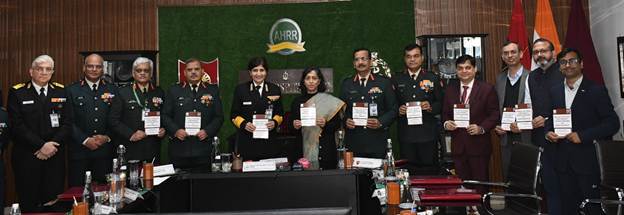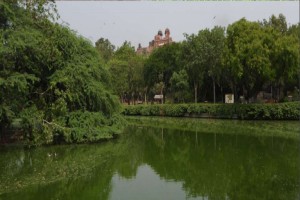
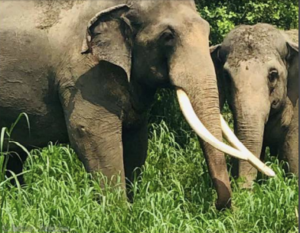 New Delhi: As of now India has 160 zoos with 17 in the large category, 25 in medium, 35 in small, and 85 in the mini category apart from rescue centres. These zoos are not just the places to see caged animals, birds and reptiles.
New Delhi: As of now India has 160 zoos with 17 in the large category, 25 in medium, 35 in small, and 85 in the mini category apart from rescue centres. These zoos are not just the places to see caged animals, birds and reptiles.
 Zoological parks, or zoos, are also huge sources of direct and indirect employment opportunities across many sections of society. We know that human resource is required to manage day-to-day activities in a zoo which include administration, veterinary services, maintenance, research, gardening, that provide direct employment opportunities to its staff, making it one of the key services provided by the zoo.
Zoological parks, or zoos, are also huge sources of direct and indirect employment opportunities across many sections of society. We know that human resource is required to manage day-to-day activities in a zoo which include administration, veterinary services, maintenance, research, gardening, that provide direct employment opportunities to its staff, making it one of the key services provided by the zoo.
 In addition to the workforce engaged in day-to-day operations, zoos also generate indirect employment opportunities in the informal sector. These constitute the local tea stalls, eateries, bookstalls, etc., situated on the periphery of the zoos. Several hawkers/sellers and other small businesses, including ice-cream sellers, balloon stalls, popcorn stalls, toy sellers, small souvenir shops, operate outside the compound of zoos in India. To ferry large numbers of visitors coming to the zoo each day, some permanent transportation modes also ply inside (e.g. battery-operated vehicles) and outside (e.g. auto-rickshaws, mini-buses, vans) the zoo.
In addition to the workforce engaged in day-to-day operations, zoos also generate indirect employment opportunities in the informal sector. These constitute the local tea stalls, eateries, bookstalls, etc., situated on the periphery of the zoos. Several hawkers/sellers and other small businesses, including ice-cream sellers, balloon stalls, popcorn stalls, toy sellers, small souvenir shops, operate outside the compound of zoos in India. To ferry large numbers of visitors coming to the zoo each day, some permanent transportation modes also ply inside (e.g. battery-operated vehicles) and outside (e.g. auto-rickshaws, mini-buses, vans) the zoo.
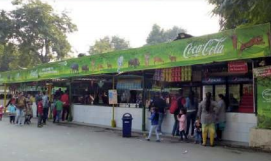 If we take the example of the Delhi zoo, it also generates employment by providing direct additional services and outsourcing contractual services to operate four refreshment kiosks/outlets, twelve battery operated vehicles, one ATM, one restaurant situated next to the ticketing counter of the zoo, and a parking complex. The zoo’s budgetary allocation in 2017-18 was Rs.4100 lakh with an expenditure of 4096.57 lakhs.
If we take the example of the Delhi zoo, it also generates employment by providing direct additional services and outsourcing contractual services to operate four refreshment kiosks/outlets, twelve battery operated vehicles, one ATM, one restaurant situated next to the ticketing counter of the zoo, and a parking complex. The zoo’s budgetary allocation in 2017-18 was Rs.4100 lakh with an expenditure of 4096.57 lakhs.
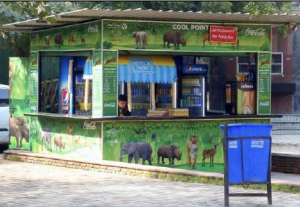 The benefits of the zoo are not only restricted to its visitors but also reach the citizens. In this context, the Central Zoo Authority (CZA) had recently requested The Energy and Resources Institute (TERI) to conduct a study titled ‘Economic valuation of ecosystem services of National Zoological Park, New Delhi‘ to understand the annual value of key ecosystem services such as biodiversity conservation, carbon storage, and sequestration, employment generation, recreational and cultural, education and research.
The benefits of the zoo are not only restricted to its visitors but also reach the citizens. In this context, the Central Zoo Authority (CZA) had recently requested The Energy and Resources Institute (TERI) to conduct a study titled ‘Economic valuation of ecosystem services of National Zoological Park, New Delhi‘ to understand the annual value of key ecosystem services such as biodiversity conservation, carbon storage, and sequestration, employment generation, recreational and cultural, education and research.
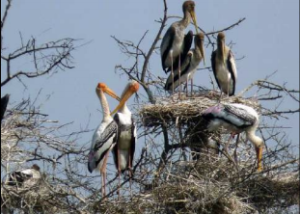 This study was ‘first of its kind’ for habitats such as zoological parks in India. The study was based on the data collected for the year 2019-20m which hence needs to be considered as the baseline year. Its findings about the Delhi zoo or the National Zoological Park was a revelation.
This study was ‘first of its kind’ for habitats such as zoological parks in India. The study was based on the data collected for the year 2019-20m which hence needs to be considered as the baseline year. Its findings about the Delhi zoo or the National Zoological Park was a revelation.
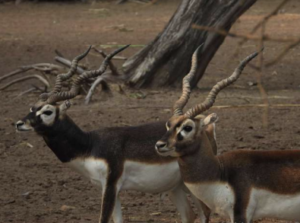 Obviously the zoo is a famous destination on the tourism map of India’s capital city. It’s foundation was laid in 1953 and officially inaugurated on 1 November 1959. It was given the status of ‘National Zoological Park’ with the prime objective of it being the model zoo in the country. Located on the periphery of the historic Old Fort, the zoo is surrounded by the ruins of Azimganj Sarai near Sunder Nursery, which adds a cultural flavor to the aura of the zoo, thereby enhancing its aesthetic beauty.
Obviously the zoo is a famous destination on the tourism map of India’s capital city. It’s foundation was laid in 1953 and officially inaugurated on 1 November 1959. It was given the status of ‘National Zoological Park’ with the prime objective of it being the model zoo in the country. Located on the periphery of the historic Old Fort, the zoo is surrounded by the ruins of Azimganj Sarai near Sunder Nursery, which adds a cultural flavor to the aura of the zoo, thereby enhancing its aesthetic beauty.
The Delhi zoo spreads across 176 acres, of which, in terms of habitat, forests form almost 72% area (51.45 ha), grasslands form 9% area (6.02 ha), wetlands form 6% area (4.14 ha), and the built-up area covers 13% (9.46 ha) of the total area. It is home to several species of mammals, birds, and reptiles from around the world.
 As of 2018, there are 40 species of endangered animals under Schedule I and II categories; 35 species of animals under Schedule III and IV categories; and 29 species of exotic animals as specified under the Indian Wildlife (Protection) Act, 1972 in the Delhi zoo.
As of 2018, there are 40 species of endangered animals under Schedule I and II categories; 35 species of animals under Schedule III and IV categories; and 29 species of exotic animals as specified under the Indian Wildlife (Protection) Act, 1972 in the Delhi zoo.
Apart from enclosures for wild animals and administrative buildings, the zoo sustains a natural environment in its campus which provides habitat for several free-ranging floral and faunal species.
 The wetlands in the park provide habitat to various wetland bird species such as Cormorant (Microcarbo niger), Darter (Anhinga melanogaster), Spot billed duck (Anas poecilorhyncha), Common teal (Anas crecca), Painted Storks (Mycteria leucocephala), and Great white pelicans (Pelecanus onocrotalus).
The wetlands in the park provide habitat to various wetland bird species such as Cormorant (Microcarbo niger), Darter (Anhinga melanogaster), Spot billed duck (Anas poecilorhyncha), Common teal (Anas crecca), Painted Storks (Mycteria leucocephala), and Great white pelicans (Pelecanus onocrotalus).
There are 5 species of free-ranging mammals such as Palm civet (Paradoxurus hermaphroditus), Porcupine (Hystrix indica), Mongoose (Herpestes edwardsi), Squirrel (Funambulus palmarum) and bats, 76 species of birds, and 4 species of reptiles in the zoo.
Also see: Wildlife Week – 1: Government mulls upgradation of zoos on PPP model
A compilation of the floral species growing inside the zoo was conducted by Dr. H. B. Naithani in 2008. He documented 123 species of trees including Cordia dichotoma, Ficus benghalensis, Bombax ceiba, Millettia peguensis, Leucaena leucocephala, Nyctanthes arbor-tristis, and Holoptelea integrifolia.
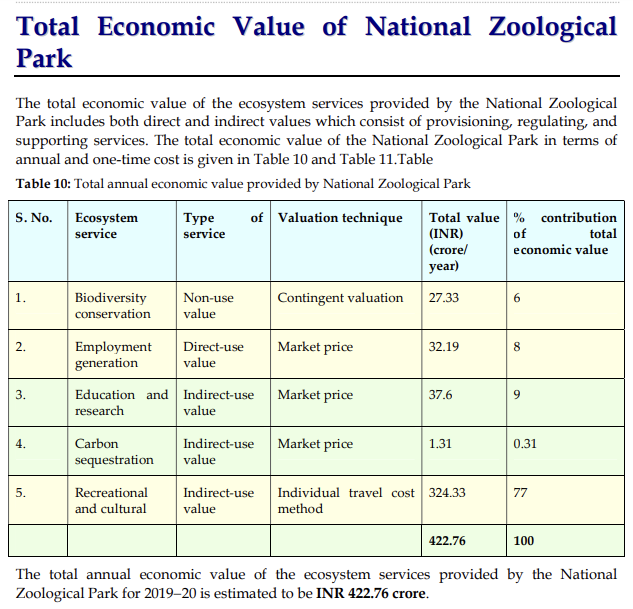
While the main aim of Delhi zoo is to provide education, conduct research, create awareness and generate interest among the visitors and inspire them to support and contribute to the cause of conservation of wildlife and its habitat, the natural areas of forests, grasslands, and wetlands also perform the key function of carbon sequestration, thereby reducing the pollution levels in Delhi. Quantifying these benefits in monetary terms, the CZA-TERI study revealed the total annual economic value of the ecosystem services provided by the National Zoological Park for 2019-20 was estimated to be Rs. 422.76 crore. Besides, the total value of the onetime cost of services and land value provided by the zoo, which was estimated to be Rs. 55,209.45 crore. Almost 77% of the contribution comes from the recreational and cultural service which indicates the significance of this service to the zoo. Education and research, the next most important service, contributes 9% to the total economic value.
 Of course, the Delhi zoo campus not only ensures infrastructural facilities for animal enclosures, hospitals, and offices but also harbours natural vegetation patches and wetlands which are important habitats for the local flora and fauna. These natural areas provide various ecosystem services particularly to the zoo visitors and the city of Delhi at large.
Of course, the Delhi zoo campus not only ensures infrastructural facilities for animal enclosures, hospitals, and offices but also harbours natural vegetation patches and wetlands which are important habitats for the local flora and fauna. These natural areas provide various ecosystem services particularly to the zoo visitors and the city of Delhi at large.
As research is one of its key objectives, the zoo is therefore, also proactively involved in organizing conservation, educational, and awareness programmes to spread awareness among the people. It has been encouraging and helping young researchers to carry out activities such as maintaining study books, animal history cards, and carrying out chemical analysis, pathology, and parasitology of endangered animal species. Several research studies have already been undertaken in the zoo such as study on Breeding patterns in pheasants, study on Asiatic Lion in captivity, and behavioral study of Sangai deer.
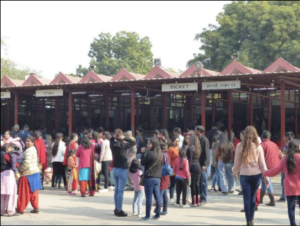 The view of the Fort in the background is a delight for tourists. Most of the national or foreign tourists who visit Delhi make it a point to visit the zoo, which is a ‘must-see’ place in the capital. Hundreds of tourists visit the zoo daily to view the animals and spend leisure time.
The view of the Fort in the background is a delight for tourists. Most of the national or foreign tourists who visit Delhi make it a point to visit the zoo, which is a ‘must-see’ place in the capital. Hundreds of tourists visit the zoo daily to view the animals and spend leisure time. 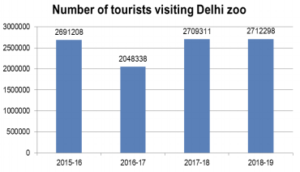 The number of tourists visiting the Delhi zoo has grown consistently over the years. In 2018-19, 19,568 foreign tourists and 2,692,730 domestic tourists visited the zoo. Over the years, the number of visitors thronging the zoo has been increasing, which is also an indication of it being a prime tourist spot in Delhi. In 2017-18, Rs. 1218.80 lakh was collected as revenue. Of this, Rs. 1022.23 lakh came from the entry fees and INR 196.57 lakh from the license fees from the contractors, who used the zoo space.
The number of tourists visiting the Delhi zoo has grown consistently over the years. In 2018-19, 19,568 foreign tourists and 2,692,730 domestic tourists visited the zoo. Over the years, the number of visitors thronging the zoo has been increasing, which is also an indication of it being a prime tourist spot in Delhi. In 2017-18, Rs. 1218.80 lakh was collected as revenue. Of this, Rs. 1022.23 lakh came from the entry fees and INR 196.57 lakh from the license fees from the contractors, who used the zoo space.
– globalbihari bureau




